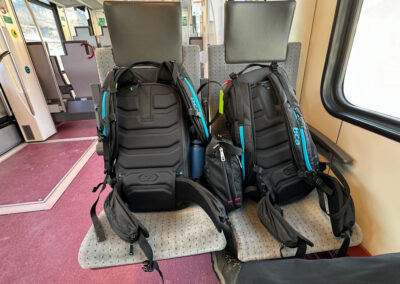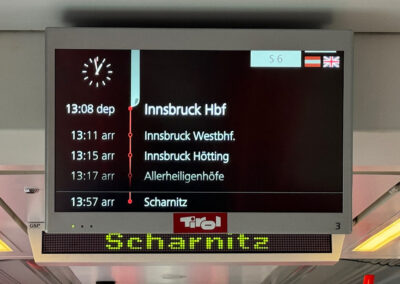Day 18 – Our Journey To Seefeld
Today’s Adventure
Wednesday was a travel day as Cindy and I re-located from San Candido, Italy, to Seefeld, Austria. The four hour trip involved a Südtirolmobil regional train from San Candido to Fortezza, a EuroCity Express train from Fortezza to Innsbruck, and then an ÖBB S-Bahn regional train from Innsbruck to Seefeld. ÖBB is an acronym for the Österreichische Bundesbahnen, i.e. the Austrian state railway. It’s fun to say but a bear to spell!
This is always an interesting segment of the trip heading north out of Italy as the EuroCity train goes up and over the Brenner Pass, a mountain pass over the Alps which forms the border between Italy and Austria. The pass lies at a relatively low altitude of 1,371 meters or 4,500 feet. The history of this pass is quite significant as it has played a key role geographically, militarily, politically, and financially for millennia.
Archaeologists have determined that prehistoric man used the Brenner Pass as far back as the most recent Ice Age. The Romans then built the first substantial road across the pass sometime around the 2nd century AD. A big milestone in the history of the pass took place during Austrian Empire when the Brenner Railway was completed in 1867. This was the first railway to transit the Alps without the use of a major tunnel.
 At the end of World War I, control of the Brenner Pass and the area surrounding it immediately to the south (what is now the province of Südtirol or Alto Adige) transferred to Italy as part of war reparations. Italian troops occupied the area soon afterwards. While officially part of Italy, the province remains strongly Germanic and the majority of the residents still speak German as their primary language. The Südtirol is one of five constitutionally-recognized autonomous regions within Italy that receive special benefits in order to help protect their unique cultural legacy. The others are Sicily, Sardinia, Trentino-Alto Adige/Südtirol, Friuli-Venezia Giulia, and Valle d’Aosta.
At the end of World War I, control of the Brenner Pass and the area surrounding it immediately to the south (what is now the province of Südtirol or Alto Adige) transferred to Italy as part of war reparations. Italian troops occupied the area soon afterwards. While officially part of Italy, the province remains strongly Germanic and the majority of the residents still speak German as their primary language. The Südtirol is one of five constitutionally-recognized autonomous regions within Italy that receive special benefits in order to help protect their unique cultural legacy. The others are Sicily, Sardinia, Trentino-Alto Adige/Südtirol, Friuli-Venezia Giulia, and Valle d’Aosta.
 The Brenner Pass was site of a meeting between Adolf Hitler and Benito Mussolini to celebrate their ‘Pact of Steel’ in March of 1940. Following the Italian armistice with the Allies in September of 1943 the Brenner Pass and surrounding area were annexed by Nazi Germany, thus shifting the border with Italy further south. The US Army occupied the area and returned control to Italy after the end of the war. Of note, the Brenner Pass was part of a so called ‘ratline’ or escape route used by many senior Nazis fleeing from the Allies after the war.
The Brenner Pass was site of a meeting between Adolf Hitler and Benito Mussolini to celebrate their ‘Pact of Steel’ in March of 1940. Following the Italian armistice with the Allies in September of 1943 the Brenner Pass and surrounding area were annexed by Nazi Germany, thus shifting the border with Italy further south. The US Army occupied the area and returned control to Italy after the end of the war. Of note, the Brenner Pass was part of a so called ‘ratline’ or escape route used by many senior Nazis fleeing from the Allies after the war.
The importance of the Brenner Pass continues to this day as there is a major four lane motorway passing through that connect strategic points north and south within the European Union. The Brenner Autobahn (Autostrada del Brennero in Italian) starts in Innsbruck, crosses the Brenner Pass, and then continues through Bolzano and Verona before ending outside of Modena. In addition to the motorway there is also a major rail switching yard that services railway tracks connecting Bolzano to the south and Innsbruck to the north.
The customs and immigration control operations at Brenner Pass were removed in 1997 following the signing of the Schengen Agreement in 1992 and Austria’s entry into the EU in 1995. While this may have streamlined traffic through the pass early on the ever-increasing level of traffic in recent years has put a major strain on the road and rail infrastructure. Long and sometimes monumental traffic jams are not unusual on holidays, during weather events, and sometimes for no reason at all.
 There are plans to upgrade the railway with a series of tunnels to help alleviate traffic. Included in these plans is the Brenner Base Tunnel, a new passage that traverses the mountain beneath Brenner Pass. The groundbreaking for this tunnel took place in 2006 but substantial work didn’t start for another five years. Completion of the tunnel is not expected until 2032 at the earliest, ten years beyond the original 2022 schedule, due to significant funding issues from the various governments involved in the project.
There are plans to upgrade the railway with a series of tunnels to help alleviate traffic. Included in these plans is the Brenner Base Tunnel, a new passage that traverses the mountain beneath Brenner Pass. The groundbreaking for this tunnel took place in 2006 but substantial work didn’t start for another five years. Completion of the tunnel is not expected until 2032 at the earliest, ten years beyond the original 2022 schedule, due to significant funding issues from the various governments involved in the project.
All that said, what we have found while riding trains over the Brenner Pass is that the historic importance of the area has been buried beneath an unfortunate layer of modern commerce. Aside from the rail switching yard, most of what you see looks more or like any major interstate interchange in the US – there’s a large outlet shopping centre along with various supermarkets, restaurants, hotels, cafés, and of course gas stations. About the only real sign that you’re crossing a the border between Italy and Austria is that your train will stop briefly while the crew is changed from Trenitalia (Italy) to OBB (Austria). You’ll also see some polizia / polizei quickly walk through the train just to make sure that everything is in order before you start to roll on down the other side of the pass.
For Innichen’s main page click here.
For Seefeld’s main page click here.
For the entire trip’s main page click here.
Today’s Maps
Hiking Log
0.0 Total Miles
0′ Cumulative Vertical
0:00 Time On Trail
The Meals
Breakfast : Zin Senfter
Lunch : On The Train
Dinner : Hotel Haymon























